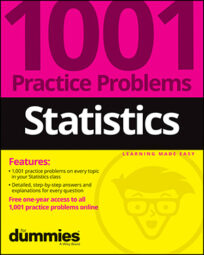When interpreting graphs in statistics, you might find yourself having to compare two or more graphs. The following histograms represent the grades on a common final exam from two different sections of the same university calculus class.
![[Credit: Illustration by Ryan Sneed]](https://www.dummies.com/wp-content/uploads/451440.image0.jpg)
![[Credit: Illustration by Ryan Sneed]](https://www.dummies.com/wp-content/uploads/451441.image1.jpg)
Sample questions
How would you describe the distributions of grades in these two sections?
Answer: Section 1 is approximately normal; Section 2 is approximately uniform.
Section 1 is clearly close to normal because it has an approximate bell shape. Section 2 is close to uniform because the heights of the bars are roughly equal all the way across.
Which section's grade distribution has the greater range?
Answer: They are the same.
The range of values lets you know where the highest and lowest values are. The grades are shown on the x-axis of each graph. Section 1's grades go from 70 to 90, and Section 2's grades go from 70 to 90, so they are the same.
How do you expect the mean and median of the grades in Section 1 to compare to each other?
Answer: They will be similar.
In both cases, the data appear to be fairly symmetric, which means that if you draw a line right down the middle of each graph, the shape of the data looks about the same on each side. For symmetric data, no skewness exists, so the average and the middle value (median) are similar.
How do you expect the mean and median of the grades in Section 2 to compare to each other?
Answer: They will be similar.
In both cases, the data appear to be fairly symmetric, which means that if you draw a line right down the middle of each graph, the shape of the data looks about the same on each side. For symmetric data, no skewness exists, so the average and the middle value (median) are similar.
Judging by the histogram, what is the best estimate for the median of Section 1's grades?
Answer: 78.75 to 80
Because the sample size is 100, the median will be between the 50th and 51st data value when the data is sorted from lowest to highest. To find the bar that contains the median, count the heights of the bars until you reach 50 and 51. The bar containing the median has the range 78.75 to 80.
Judging by the histogram, which interval most likely contains the median of Section 2's grades?
(A) below 75
(B) 75 to 77.5
(C) 77.5 to 82.5
(D) 85 to 90
(E) above 90
Answer: 77.5 to 82.5
Because the sample size is 100, the median will be between the 50th and 51st data value when the data is sorted from lowest to highest.
To find the bar that contains the median, count the heights of the bars until you reach or pass 50 and 51. The bar containing the 50th data value has the range 77.5 to 80. The bar containing the 51st data value has the range 80 to 82.5. Thus the median is approximately 80 (the value that borders both intervals).
Which section's grade distribution do you expect to have a greater standard deviation, and why?
Answer: Section 2, because a flat histogram has more variability than a bell-shaped histogram of a similar range.
Standard deviation is the average distance the data is from the mean. When the data is flat, it has a large average distance from the mean, overall, but if the data has a bell shape (normal), much more data is close to the mean, and the standard deviation is lower.
If you need more practice on this and other topics from your statistics course, visit 1,001 Statistics Practice Problems For Dummies to purchase online access to 1,001 statistics practice problems! We can help you track your performance, see where you need to study, and create customized problem sets to master your stats skills.

